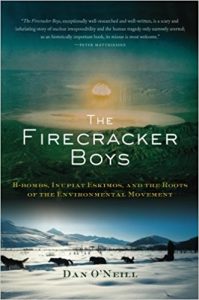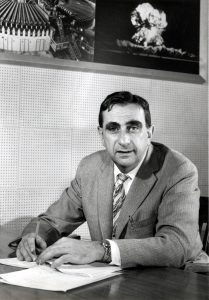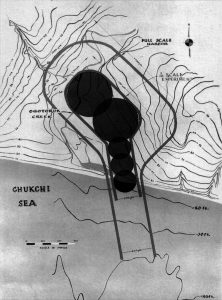
Fukushima, Chernobyl, Three Mile Island, and… Point Hope?
You might initially think that the book “The Firecracker Boys” doesn’t have anything to do with gardening in Alaska. Yet it has everything to do with gardening in Alaska. How can you safely garden anywhere if the soil is contaminated with radioactive material? Can you imagine having to test your soil for radioactive material? If Edward Teller had his way, several atomic bombs would have been set off in various locations in Alaska, and people would have had to worry about large amounts of contaminated soil. Imagine if Point Hope were added to a list of other names: Fukushima, Cherynobl, Three Island Mile. Who wants to plant a garden where there is large amounts of nuclear waste? To begin to comprehend this story, one must first learn a little about Edward Teller.

Edward Teller
Edward Teller was a brilliant Jewish scientist and mathematician born in Hungary 1908 who moved to the United States in the 1930s where he joined the Manhatten Project to develop nuclear bombs to end World War II. Teller became known as the “Father of the Hydrogen Bomb.” He was a very driven man who pushed hard for what he believed in. To his credit, had it not been for hard working people like Teller, the US might not have won the war.
Project Chariot
In 1958, the Atomic Energy Commission (AEC) pushed hard and fast to set off nuclear bombs in Alaska.

They set sights on several locations but zeroed in on Point Hope. The named it “Project Chariot.” Over the years, I had heard bits and pieces of Project Chariot, but it was not until I started reading Dan O’Neill’s book did I begin to grasp the depth of the project. The AEC wanted to use nuclear bombs to build a boat harbor in northwest Alaska near Point Hope. According to O’Neill, employees of AEC were not truthful to the public, saying that there was little risk of nuclear fallout.
The Reaction
People did not believe the AEC employees and rallied against Project Chariot. The Inupiat of Point Hope actually recorded the AEC presentations which captured what AEC employees said during their public presentations. These audio recordings became invaluable for historical researchers such as Dan O’Neill. Instead of people saying, “Well, Ed Teller said…” this or that, the taped audio recordings captured the actual words of Teller and others. Each one of their statements could be then repudiated point by point.
People from all walks of life heard about the project, stopped for a moment, said words to the effect of, “What in the world?” Scientists, professors, Inupiat, preachers, what-was-then termed housewives. They picked up their telephones. They got onto their typewriters. They cranked up their mimeograph machines. They got envelops and stamps. They bravely stepped up and said, just because a government agency is saying something, just because a government scientist is saying something, this doesn’t mean that we have to believe it and that we have no other choice. We in the United States have freedom of speech, and freedom of access to truthful information. We have freedom to unbiased information, freedom from propaganda.
The Cost
There is a sayings that the truth will set you free and that freedom is not free. For those who lobbied against Project Chariot, there ended up being a price to pay. University of Alaska scientists and professors who spoke up, trying to reveal the truth, paid dearly with their academic careers. Rather than quietly accepting the funding, rather than allowing their field research to be covered up with lies, they bravely stepped forward to provides the facts – the foundation of academic work. Rather than being heralded as heroes, they were fired and then blacklisted. O’Neill postulates that one of the scientists lost his life due to his conviction of standing up to speak the truth.
If Not Point Hope – What About the Alaska Peninsula or Aleutian Islands?
During the push to detonate atomic bombs in the Point Hope area, alternative projects included blasting a canal across the Alaska Peninsula at Port Moller and setting of nuclear bombs in the Aleutian Islands. After the defeat of Project Chariot, the AEC detonated three nuclear bombs in the Aleutian Islands. Although Amchitka Island was portrayed as being useless before Cannikin, Longshot, and Millrow were detonated,

they were actually the sacred homelands of the Unangax people.
In Unangax culture – unlike Western culture – things (the water, the ocean, the sky, the ancestors) are alive and inhabit everything (Laughlin, 1980). Even after Aleutian Islands were systematically depopulated by Europeans in the 1700s and 1800s (Veniaminov, 1984), in the spiritual beliefs of those who survived, the ocean, the islands, and the people who did not physically survive, they were still there, still to be respected (Kohloff, 2002).
To attempt to put one’s self in the mind of the Unangax people, imagine setting of nuclear explosions in some of the largest US cities today – New York, Los Angeles, Chicago – all for the purpose of research. But, wait, one might say, there are people living there? And you are still going to set off nuclear explosions? In Unangax spiritual beliefs, there were still living beings living in Amchitka when the following nuclear bombs were detonated: Long Shot (80-kiloton in 1965); Milrow (one-megaton in 1969), and Cannikin (five megaton in 1971 – the largest underground in the US).
But Wait – There’s More
But that wasn’t enough. Scientists collected nuclear material from Nevada, secretly transported it to the Point Hope area, and deposited the radioactive material into the land and streams without any notice to anyone. It was not until 1992 when Dan O’Neill was researching his book and after filing several FOIs (Freedom of Information) requests was this information revealed to the public. How would you feel if – 30 years from now, you learn that a government intentionally dumped nuclear waste into your drinking supply or your garden – without informing you? Would the US government intentionally expose Alaska Natives to pathogens without informed consent – as occurred with African Americans during the Tuskegee experiment (Jones, 1981) from 1932 to 1972?
Racism in the 1950s and 1960s
If you are an Alaskan who loves your state – particularly if you are Alaska Native – it is a challenge to remain neutral on the topic. O’Neill’s book captures the racism that prevailed in the US during the 1950s and 1960s, that Alaska was an ugly wasteland and that Alaska Natives were dispensable, that their lives were of little or no value, particularly if it meant gaining information for the benefit of non-Natives.
Incredible?
There are parts of the book that are hard to read – even unbelievable. Would the US government intentionally inject known pathogens into US citizens – just to learn the affects? Would the US government – or its agents – shorten the lifespan of an Alaskan scientist who dared speak up? Would the US government send agents to spy on citizens who stepped in the way of progress? I had difficulty believing parts of O’Neill’s book. But you be the judge. Compare what Teller (or his agents) said to what O’Neill wrote. If you care about gardening in Alaska, you will take the time, find the book, and read it. Clearly, Teller believed in what he was doing – or wanting to do. So did O’Neill.
Conclusion
O’Neill’s book is a must read for anyone in Alaska interested in gardening. This short summary cannot capture the disbelief of what some people in the late 1950s and early 1960s wanted to do. O’Neill is a highly gifted writer which reflects the level of his deep researching and his attempts to remain neutral on the topic. Teller was brilliant, but it would have been nice if he had thought a little bit more about other human beings and about the long-term well being of others living on planet Earth. Truthfulness and honesty – knowing the basic difference between right and wrong – rather than being driving by greed for fame would have also assisted. O’Neill asserts that it is the obligation of common citizens to have the bravery to stand up and voice concerns. Point Hope now rests not as ground zero of nuclear explosions but ground zero of major environmental movements.
References and Attributions
Amchitka Map:
This diagram shows the locations of the nuclear tests on Amchitka Island, Alaska. It was drawn in Inkscape, based upon fig 2 in this document. It is also a derivative work of the GFDL Radiation warning symbol. The diagram is released under GFDL.
Firecracker Boys Photograph: Amazon.
Jones, James H. “Bad Blood: The Tuskegee Syphilis Experiment.” 1981. New York: The Free Press.
Kohloff, Dean. “Amchitka and the Bomb: Nuclear Testing in Alaska.” 2002. Seattle: University of Washington Press.
Laughlin, William. “Aleuts: Survivors of the Bering Land Bridge.” 1980. New York: Holt, Rinehart, and Winston.
O’Neill, Dan “The Firecracker Boys: H-Bombs, Inupiat Eskimos, and the Roots of the Environmental Movement”. 2007. Phoenix, Arizona: Basic Books.
Project Chariot Photograph: Source: Scanned from Dan O’Neill, The Firecracker Boys (New York: St. Martin’s Press, 1994). License: Identified as Lawrence Livermore National Laboratory image.
Teller Photograph: Permission details PD-USGov-DOE (original), cc-by-sa-3.0 (this derivative)
Veniaminov, Ivan. “Notes on the Islands of the Unalaskhka District.” 1984. Fairbanks: University of Alaska Fairbanks.
About mlivingston2
Twitter •